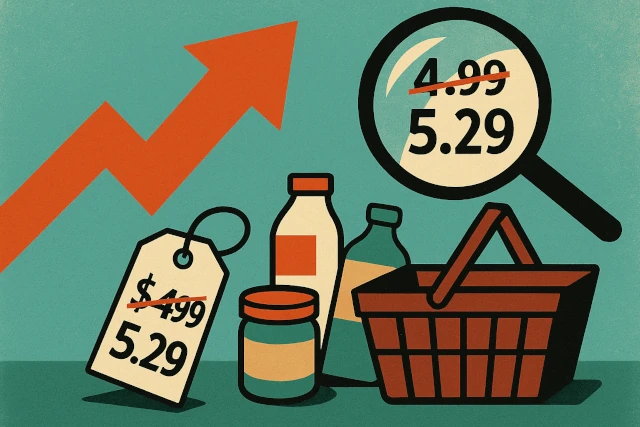What’s the Real Playbook for Raising Prices Without Killing Off Velocity?

Inflation is real. Margins are tight. And raising prices? It's necessary—but risky. I’ve built and scaled several food brands over the years, and the truth is this: raising prices without losing shelf velocity is one of the trickiest balancing acts in the CPG world. You need a plan—because winging it can cost you doors, sales, and goodwill.
Why You Can’t Just Raise Prices Blindly
Many emerging founders think a simple spreadsheet calculation is enough: “My costs went up 18%, so my SRP needs to go up 18% too.” But retail doesn’t work like that. Every pricing decision reverberates through your velocity, buyer relationships, and competitive positioning. Here’s what’s at stake:
- Retailer pushback: Buyers hate surprises and unexplained margin erosion.
- Shopper resistance: Price-sensitive consumers have options—and will switch.
- Category reset danger: Too big a jump can get you flagged at the next category review.
Step 1: Build a Clear Justification
Before you talk to retailers, build a narrative they can repeat internally. Good pricing communication includes:
- Cost justification: Show inputs that have risen—ingredients, freight, packaging.
- Market alignment: Provide competitive benchmarks to show your SRP is still fair.
- Value story: Remind them of your brand’s pull-through, loyal customers, and basket size uplift.
Prepare a one-pager or slide deck for your brokers and buyer meetings. Keep it data-backed and non-emotional.
Step 2: Know Buyer Tolerance Thresholds
Every category is different, but there are rough norms on what buyers will accept before they balk. Here’s a quick breakdown:
- < 5%: Usually accepted with minimal friction—especially if your last increase was over 12 months ago.
- 5–10%: Expect questions and negotiation—come with a strong value or cost story.
- 10–15%: High risk. Combine with added value (e.g., pack size change or temporary promotions).
- >15%: Strategic relaunch territory. Consider rebranding or repositioning the product entirely.
Talk to other founders in your category. Often, buyers will accept price hikes more easily if multiple brands are moving in sync.
Step 3: Time It Strategically
There’s a wrong time to raise prices: right before a reset or during a retailer’s margin re-negotiation cycle. Instead:
- Bundle your price increase with other changes—like a new pack format or merchandising initiative.
- Avoid the holidays unless you’re in gifting or indulgence categories.
- Use inflationary windows (e.g. when national brands are raising prices) to move with the tide.
Step 4: Sweeten the Deal with Temporary Price Reductions (TPRs)
One of the smartest ways to mask the short-term pain of a price increase is to immediately support it with a TPR. Here’s how:
- Stack your launch: Raise your list price and offer a 4–6 week promo to keep velocity intact.
- Use it as a story: “We’re raising prices due to cost pressure, but investing in our consumers with a short-term promo.”
- Plan trade spend carefully: Make sure you don’t erase your new margin gains with over-discounting.
Step 5: Consider Value-Added Sizing
If you’re raising prices significantly, it may make more sense to shift pack sizes. You can either:
- Upsize: Move from a 6oz to an 8oz pack and raise the SRP proportionally—this gives the appearance of added value.
- Multi-pack: Bundle multiple smaller items into one shelf SKU to hit price points more comfortably.
This approach often creates less sticker shock while still achieving better margin per unit sold.
Step 6: Communicate with Your Customers
Don’t let your most loyal fans hear about your price increase from the shelf tag. A short email, social post, or packaging insert can go a long way:
- Explain the why, honestly. Be human, not corporate.
- Thank them for their loyalty and invite feedback.
- Consider a short-term DTC coupon code as a goodwill gesture.
Step 7: Watch Your Data Closely
Velocity post-increase should be monitored at least weekly for the first 6–8 weeks. Use:
- Retailer POS portals
- SPINS/IRI/Nielsen syndicated data
- Broker or distributor reporting
If sales start dropping, take quick action—run a promo, reinforce your in-store support, or reconsider your sizing or value message.
Bonus: Psychological Pricing Tactics
Small pricing tricks can help ease the transition:
- Don’t jump above key thresholds: e.g. $4.99 → $5.49 is safer than $5.01.
- Use 9s: $3.99 feels more acceptable than $4.00—even if we all know the game.
- Reinforce brand value: New reviews, awards, or certifications can justify the new price.
Final Thoughts
Raising prices doesn’t have to be a death sentence for your velocity. But it does have to be thoughtful. Start with a data-backed justification. Bring your buyers along for the journey. Support your price change with promotional and value-based strategies. And most importantly, monitor and adjust in real time.











